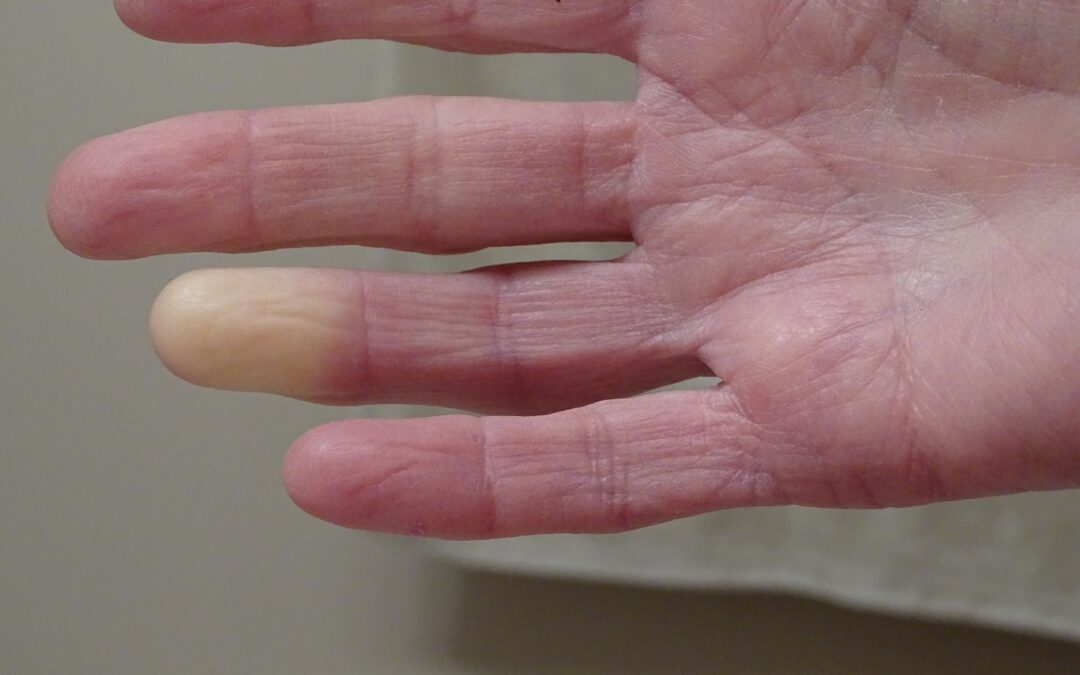If you’ve ever spent some time outdoors when temperatures drop to or below zero, you know that failing to wear gloves can leave your fingers tingling or even feeling numb. For most people, your hands will need to be exposed to cold for an extended period of time for those painful sensations to start, or temperatures need to be extreme.
However, some individuals experience a painful prickling sensation, tingling, and even discoloration after just a couple of minutes of exposure. In some instances, these symptoms might even occur without exposure to cold weather.
Raynaud’s Phenomenon is also known as Raynaud’s Syndrome. It is believed to affect between 3 and 5 percent of adults around the world. This condition impacts your body’s response to cold temperatures, as well as to emotional situations. While not life-threatening, this condition can be incredibly painful and can impact an individual’s use of their hands and fingers.
Keep reading to learn more about this little-known condition. Then, learn how our experts in St George hand and wrist surgery can help.
What is Raynaud’s Phenomenon?
Despite impacting more than 134 million people worldwide, Raynaud’s Phenomenon is relatively unknown. Symptoms can be minor and may be mistaken for simply reacting to the cold. Because of this, many people may have Raynaud’s Syndrome without ever realizing it.
Raynaud Phenomenon is a medical condition that affects your body’s reaction to cold temperatures or emotional stress. The condition impacts small blood vessels in your hand, called arterioles. Raynaud’s Syndrome most commonly impacts the arterioles located in the hands. But it can also impact the ears, nose, knees, toes, or nipples.
In an individual with Raynaud’s Phenomenon, when they experience cold weather or stress, they experience spasms, also called vasospasms, in their arterioles. This can disrupt blood circulation in the affected blood vessels, leading to painful side effects.
Symptoms and Side Effects
Because tingling or numbness in your fingers and toes, when exposed to cold air, is a common reaction, this common symptom of Raynaud’s Syndrome is often overlooked. However, individuals with Raynaud’s Phenomenon may also notice that their fingers or other impacted areas of skin turn white and then blue after cold exposure. This can happen in as little as 15 minutes of mild cold exposure.
When your hands begin to warm, your fingers or other impacted areas will typically turn red. Numbness may continue as your body warms, or you may experience painful stinging or a prickly feeling. Swelling of the fingers, toes, or other impacted body parts may also occur.
Causes
Researchers aren’t sure what causes Raynaud’s Phenomenon. While it is known that cold temperatures can trigger an attack, it’s unclear why stressful situations can also cause the symptoms of Raynaud’s Syndrome to begin. Some individuals may only experience the symptoms after cold exposure, while others may experience them following emotional moments as well.
While the initial cause of Raynaud’s Syndrome is unknown, what is known is that the symptoms can worsen over time. Each time that an individual experiences an episode of Raynaud’s Phenomenon, the arteries in your hands, toes, or other affected areas narrow. Over time, these small arteries may actually thicken. This can further limit blood flow, and make the symptoms of this condition even more painful. The narrowing of arteries may also lead to the risk of other medical conditions.
Types of Raynaud’s Phenomenon
There are actually two different types of Raynaud’s Syndrome; Primary and Secondary. Primary Raynaud is the most common form of this condition. This type of syndrome isn’t caused by any underlying medical conditions.
With Secondary Raynaud’s Phenomenon, an underlying health condition leads to the development of this condition. This version of Raynaud’s Syndrome is less common but often causes more serious symptoms.
Some medical conditions that can cause Secondary Raynaud’s include:
- Artery Diseases: Diseases that cause a buildup of fatty deposits in blood vessels leading to the heart can cause the blood vessels of the hands and feet to become inflamed.
- Carpal Tunnel Syndrome: The pressure caused by Carpal Tunnel Syndrome can impact how the blood vessels in your hands react to cold temperatures.
- Ulnar Nerve Entrapment: Similar to Carpal Tunnel Syndrome, the pressure caused by Ulnar Nerve Entrapment can also lead to the development of Secondary Raynaud’s Syndrome.
- Smoking: Because smoking can cause narrowing blood vessels, it can also lead to the development of Secondary Raynaud’s Phenomenon.
Connective tissue diseases, injuries impacting the hands or feet, and certain medications for high blood pressure, migraine, or cancer, can also cause Secondary Raynaud’s Syndrome.
Who is at Risk of Developing Raynaud’s Syndrome?
In addition to the above conditions that can lead to the development of Raynaud’s Syndrome, there are some other risk factors that can increase a person’s risk of developing this condition.
Raynaud’s Phenomenon affects more women than men, and most commonly affects individuals between the ages of 15 and 30. Diagnosis of this condition is more common in areas that experience cold weather.
While a genetic connection hasn’t been proven, having a direct family member, like a sibling, parent, or child, with Raynaud’s Syndrome appears to increase a person’s risk of developing it.
Treating Raynaud’s Syndrome
Most cases of Raynaud’s Syndrome do not require medical treatment. Symptoms are often rare and can be managed by bundling up against the cold or avoiding cold weather altogether.
However, in some cases, this condition may become severe, and can lead to blocked arteries, skin sores, and dead tissue. If these symptoms appear, medication or surgery may be necessary. Even in more minor cases, physical therapy may be necessary to regain full range of motion in your fingers and hands after a bad episode of Raynaud’s Syndrome.
How St George Hand Surgery Experts Can Help
If you believe that you’re suffering from a serious case of Raynaud’s Phenomenon, the experts at St George hand surgery can help. Our specialists can help diagnose this condition and explore treatment options. From medication to surgery, our hand and wrist surgery experts can help you understand your options and find the right treatment for you.
Book a consultation today to learn more.

